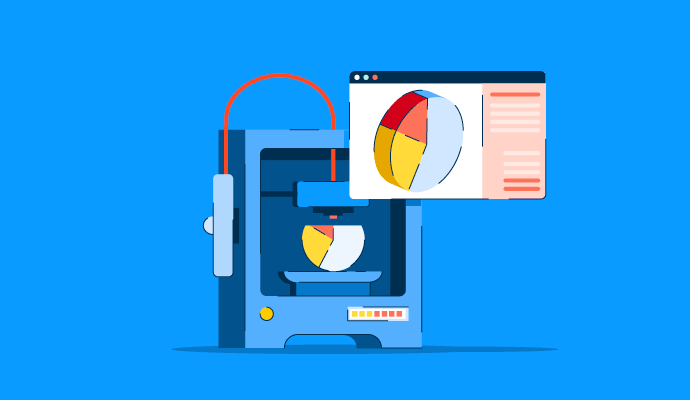3D printing has evolved significantly in recent years. Many businesses use 3D printers, with new consumers constantly entering the market.
3D printing can help anyone turn their digital designs into physical objects. For example, you can design a unique phone case on a computer and then print it out using a 3D printer. Using materials like plastic or metal, the printer would construct the casing layer by layer, creating a unique and valuable final product.
Many organizations leverage 3D printing software to translate their design into the final product that a 3D printer can understand.
Top 3D printing statistics
- The global 3D printing market size was valued at $20.37 billion in 2023.
- 82% of people say 3D printing helped them save substantial costs.
- By 2027, the market for small industrial metal printers will reach $1 billion.
- 3D printing revenue has climbed at a CAGR of 17.2% to an estimated $4.3 billion, including an estimated 19.8% growth in 2024.
- Exports make up about 90% of sales for China's 3D printer manufacturers, totaling approximately 2.032 million units.
If you’re ready to implement these insights, check out our list of the best 3D printing software to improve your workflow and produce better prints.
To learn more about the future of the 3D market, let’s dive deeper into these statistics.
General 3D printing statistics
The development of 3D printing has advanced significantly in its relatively brief history. Due to its ability to offer customization, efficiency, and intricate designs, 3D printing is positioned to revolutionize businesses and help people achieve their ideas.
Discover the top 3D printing statistics demonstrating the technology's growing significance.
- North America was the largest geographic market, with a market portion larger than 30% in 2022.
- The United States was the single-largest market, with $3.1 billion or 22%.
- 52% of all 3D printing businesses are based in Europe.
- 33% find that budget is the biggest limit for 3D printing adoption.
- The estimated market size for 3D printing in the UK is £468 million, making it the second-biggest market in Europe and the fifth-largest market globally.
- By 2030, the size of the global market is expected to increase by 20.8% annually, with a potential value of $62.76 billion (£48.88 billion).
- By 2026, the UK 3D printing market is anticipated to reach a value of £685 million, growing at a CAGR of around 10%.
- 22% use 3D printing to help them reduce manufacturing waste, while 38% expect improvements in sustainability and recyclability efforts in the next 3-5 years
$6.6 billion
is the projected global 3D printing materials market evaluation in 2033.
Source: Future Market Insights
- 61% of 3D printer users say they want to increase their investment in the technology, while only 36% want to maintain their present level.
- Customers spend over £8,000 annually on 3D printing, while 23% spend close to £80,000.
- Cost is the main barrier keeping consumers from utilizing 3D printing more regularly, according to 55% of respondents.
- German suppliers account for 62% of all PBF metal additive manufacturing (AM) systems installed worldwide.
- Between 2022 and 2027, the size of the global 3D printer market is anticipated to increase by $25million at a CAGR of 23.49%.
3D printing market statistics
The complexity of the 3D printing market makes it difficult to analyze trends in this industry. The market's three primary segments are hardware, software, and services. The actual machines or printers are referred to as hardware.
Let’s dive more into 3D printing market trends statistics to get an overview of its development worldwide.
- More than 75% of American patients with damaged skulls from disease or trauma had their implants made by Oxford Performance Materials' 3D printer, according to the company.
- In 2022, North America was anticipated to contribute 34% to the growth of the worldwide 3D printing market.
- 49% of participants in the poll from 2022 reported using 3D printing for manufacturing runs involving more than 10 items.
- The additive manufacturing (AM) market is anticipated to enjoy rapid development and double in size, reaching a worth of $37.2 billion by 2026, according to the HUBS trend analysis.
23%
is the predicted compound annual growth rate (CAGR) of the 3D printing market.
Source: IndustryArc
- Hardware commands the highest part, accounting for over 63% of the market, when the 3D printing market is divided into software, hardware, and services.
- The functional components market is expected to grow rapidly for 3D printing applications, with a compound annual growth rate (CAGR) of 21.5% by 2028.
- Metal makes up a major portion of the market for 3D printing materials, accounting for more than 48% of global revenue.
- Despite being relatively new, the ceramics market was anticipated to expand at a CAGR of 23.3% in 2022.
- By 2026, it’s anticipated that the market for CAD software and on-demand parts services will have tripled.
- Industrial printers account for a significant percentage of the 3D printing market's printer types, accounting for more than 76% of global sales.
3D printing industry statistics
3D printers are employed in various industries all around the world. There are currently so many users that industries are sometimes split into desktop and industrial categories. Industrial users operate large machinery in high-volume production, while desktop users work in smaller workshops, educational institutions, and healthcare facilities.
Let’s learn more about 3D printing industry statistics to know how the manufacturing industries have a bright future.
- The manufacturing industry increasingly relies on 3D printing for anything from specialized parts for car interiors, spaceship engines, face shields, and masks for healthcare personnel to inventive pen holders.
- The North American 3D printing market size is expected to reach USD 16.59 Billion by 2032.
- According to many analysts, the 3D printing market will expand between 18% and 27% annually, which is astoundingly fast.
- Nearly a million (993K) entry-level 3D printers were shipped worldwide in Q4 2023
- Manufacturers of 3D printers that are most profitable include AutoDesk, HP Inc., 3D Systems, Desktop Metal, and Proto Labs. AutoDesk has a market worth of more than $68.2 billion.
70%
of businesses 3d printed more parts in 2023 than in 2022.
Source: Protolabs
- More than $300 million in venture capital funding was given to 3D printing startups.
- Most companies that now utilize 3D technology (more than 23%) acknowledged investing more than $100,000 in it.
- When asked why they prefer 3D printing to alternative production techniques, 69% of respondents cited its exceptional capacity for producing intricate geometrical items, 52% praised its ability to iterate quickly, and 41% cited its capacity for mass customization.
- 38% of businesses that employ 3D printing technologies view it as their primary activity, while 18% have internal departments devoted to it and 16% use it in various areas.
- More than half of companies that use 3D printers intend to expand to new materials, while 70% anticipate discovering new use cases and applications for them soon.
- 58% are very optimistic about 3D printing's future and believe it will have a significant role in manufacturing, business, and individual life.
3D printing technology statistics
3D printing technology has benefited humanity and significantly contributed to solving pressing ecological problems. Let us learn about the most used 3D printing technology.
- The most widely used 3D printing technology is fused deposition modeling (FDM) or fused filament fabrication (FFF), like HP's Multi Jet Fusion. 71% of businesses that utilize FDM/FFF do it internally.
- The second most preferred method is selective laser sintering (SLS). However, 42% of its customers use it as an external service, which is the majority.
- The stereolithography (SLA) technology 3D printing market is projected to witness a compound annual growth rate of 19.27% and reach US$6.746 billion by 2028.
43%
expect 3D printing to help housing construction reach new heights.
Source: Protolabs
- 2.2 million 3D printers were supplied to clients globally.
- Between one and two million people use 3D printers worldwide.
- There are 168,000 installed 3D printers in the UK.
- According to 69% of businesses, the main benefit of 3D printing is its ability to produce complex shapes.
- 77% of respondents think 3D printing will have the most significant impact on the medical industry.
- Global 3D printer sales in the first half of 2024 are estimated to be around 2.152 million units. For the full year 2024, global 3D printer sales could exceed 4.5 million units.
3D printing usage statistics
Witness the revolutionary technology's incredible development, awe-inspiring applications, and limitless potential usage. Let’s pave the road for the foreseeable future with some exciting 3D printing usage statistics.
- More than 68% of companies using 3D printing use it for prototyping and pre-series manufacturing.
- 5% of investments done in 3D printing are made to purchase equipment and machines.
- 81% are satisfied with their 3D printing strategy and plan to continue it in the upcoming years.
- China exported 680,000 3D printers to the U.S., representing 37.2% of total exports in the first half of 2024.
- Germany was the second-largest market, with 360,000 units exported. Other key markets included the Netherlands, Canada, the UK, Brazil, Australia, South Korea, Japan, Russia, and Austria.
- 40% of businesses that employ 3D printing produce functional items, while 26% manufacture tools.
- 3D printing is used by 27% of businesses to produce finished consumer goods.
$406.31 million
is the assessed market size of the 3D food market by 2025.
Source: Research Nester
- The molds and tooling market is predicted to increase to $20 billion by 2030.
- All different kinds of polymers, resins, metals, cement, and even a type of ceramic can be 3D printed. Even food is printed in 3D for fine dining. The concept is simple: using additive manufacturing, complex shapes may be created for food items like chocolate and purees.
- 3D printing is used for mass manufacturing in 18% of the cases, large series in 49% of the cases, and small series in 70% of the cases by the companies who reported significant expenditures in the technology.
- Adidas is a company that manufactures 3D printed products in large quantities; its 4DFWD running shoes have 3D printed soles.
- More 3D printing might cut waste by up to 95%.
- 63% are looking for options to recycle 3D printed parts.
3D printing growth opportunities statistics
As 3D printing technology develops, materials grow more varied, and applications become more pervasive, there is a tremendous amount of room for future growth. These statistics give a complete picture of the additive manufacturing market growth and its applications.
- Only 13% are confident about using 3D printing to its full potential, meaning that their use of 3D printing should still grow for 87% of the users.
- According to 55% of the organizations polled, adopting 3D printing can boost supply chain flexibility. It will simplify logistics, transit, and stock management. Shipping material things as digital files is now a viable alternative because of 3D printing.
- According to 69% of 3D printing users, the technology needs to become more dependable and affordable. 29% of respondents claimed that they lack confidence in the dependability of 3D printing is a significant project-specific disincentive.
- Up to 71% of companies think they don't have the knowledge or training needed to use 3D printing technology efficiently.
- The market for orthopedics 3D printing is expected to reach $3.7 billion by 2027.
- Including materials, services, software, and hardware, the medical 3D printing market is presently valued at $1.25 billion.
- By 2024, the metal AM hardware market is anticipated to generate over $4 billion in revenue.
- Large companies post new 3D printing jobs regularly (36.3%), but very small entities (VSEs), small and medium-sized enterprises (SMEs), and intermediate-sized enterprises (ETIs) aren't far behind, with 30.7% of published offers.
- While 4.6% of the automobile industry has long utilized 3D printing, several manufacturers have recently decided to establish their facilities for additive production.
- A study by A.T. Kearney projects that by 2027, 3D printing will be responsible for 2-3 million new jobs.
- The market for goods and services related to 3D printing expanded to $5.1 billion in 2022.
The future is 3D
The breadth of potential 3D applications and opportunities will grow as technology's capabilities progress. 3D printing has become a popular topic in the tech industry. It is unsurprising considering how it used to take at least a year to build a house, but now we can create one in a shorter time.
Many industries are considering using 3D printing technology. These include sectors like aviation, automotive, construction, medical, and even the food industry, which employs 3D printing to enhance products and streamline manufacturing processes.
The above statistics highlight its significant capacity to transform industries and promote innovation. With manufacturers gaining a better understanding of 3D printing technology, it will be widely used to grow businesses.
Learn more about how 3D printing opens up a new horizon in the field of education.
 by Sagar Joshi / December 3, 2024
by Sagar Joshi / December 3, 2024
 by Sagar Joshi
by Sagar Joshi
 by Sagar Joshi
by Sagar Joshi
 by Sagar Joshi
by Sagar Joshi
 by Sagar Joshi
by Sagar Joshi
 by Sagar Joshi
by Sagar Joshi


